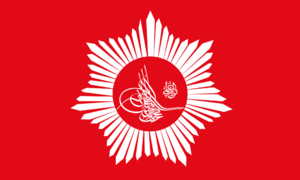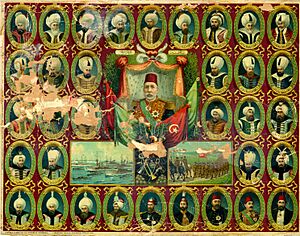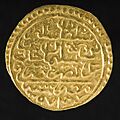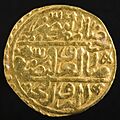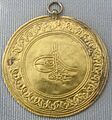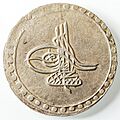List of sultans of the Ottoman Empire facts for kids
Quick facts for kids Sultan of the Ottoman Empire |
|
|---|---|
| Osmanlı padişahı | |
|
Imperial
|
|
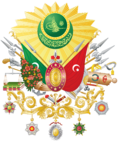
Imperial Coat of arms
|
|
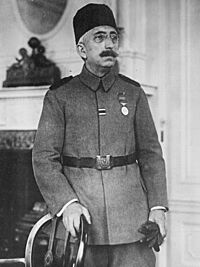
|
|
| Details | |
| Style | His Imperial Majesty |
| First monarch | Osman I (c. 1299–1323/4) |
| Last monarch | Mehmed VI (1918–1922) |
| Formation | c. 1299 |
| Abolition | 1 November 1922 |
| Residence | Palaces in Istanbul:
|
| Appointer | Hereditary |
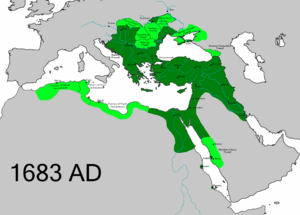
The sultans of the Ottoman Empire were powerful rulers. They belonged to the Ottoman dynasty, also known as the House of Osman. These sultans ruled a huge empire that stretched across different continents. It began around 1299 and ended in 1922.
At its peak, the Ottoman Empire was enormous. It reached from Hungary in the north to Yemen in the south. In the west, it included Algeria, and in the east, Iraq. The first capital was Söğüt, then Bursa. Later, it moved to Adrianople (now Edirne) in 1363. Finally, in 1453, Mehmed II captured Constantinople (today's Istanbul), making it the new capital.
The early history of the Ottoman Empire mixes facts with legends. The empire started at the end of the 13th century. Its first ruler, Osman I, gave the empire its name. The Ottoman family he started ruled for six centuries. There were 36 sultans in total. The Ottoman Empire ended after World War I. It had sided with the losing Central Powers. The winning Allies divided the empire. This led to the Turkish War of Independence. The sultanate was officially ended in 1922. This also led to the creation of the modern Republic of Turkey.
Contents
What were the Sultans called?
The Ottoman ruler was often called the padishah. This word was commonly used in the empire. In Europe, people sometimes called him the Grand Turk. This meant he was the ruler of the Turks. Sometimes, he was simply called the "Great Lord." This was especially true in the 16th century.
People in different parts of the empire used other names too. For example, in some Arabic documents, he was called "malik" (king). Bulgarians sometimes called him the "tsar." Greeks used the name "basileus," which was a title for Byzantine emperors.
The Sultan's Role in the Empire
For most of its history, the Ottoman Empire was an absolute monarchy. This means the sultan had complete power. By the late 1400s, the sultan was at the top of everything. He was in charge of politics, the military, justice, society, and religion. He had many titles.
The sultan was believed to be responsible only to God and God's law. This law was called şeriat (or sharia in Arabic). The sultan was the main person to carry out this law. His power was seen as a gift from heaven. Titles like "shadow of God on Earth" showed this belief. He was also called the "caliph of the face of the earth." This meant he was a leader of Islam.
All government jobs were given by the sultan. Every law he made was a special order called a firman. He was also the supreme military commander. He officially owned all the land. Osman I was the first ruler of the Ottoman state. At first, it was a small area called a beylik near the Byzantine Empire.
After Mehmed II conquered Constantinople in 1453, Ottoman sultans saw themselves as heirs to the Roman Empire. They sometimes used titles like "caesar" of Rûm or "emperor." They also became the caliphs of Islam. When a new Ottoman ruler took the throne, there was an important ceremony. He was given the Sword of Osman. This was like a coronation for European kings. If a sultan wasn't given the sword, his children couldn't become rulers.
Even though sultans had absolute power in theory, their power was limited in practice. They had to listen to important family members. They also had to consider the opinions of government officials, military leaders, and religious leaders. From the late 1500s, the sultans' direct control over the government started to lessen. This period is known as the Transformation of the Ottoman Empire.
Women in the imperial harem also played a big role. The reigning sultan's mother, called the valide sultan, was very powerful behind the scenes. They effectively ruled the empire during a time known as the Sultanate of Women.
Later, the empire became a Constitutional monarchy. This happened during the reign of Abdul Hamid II. He was the last absolute ruler and the first constitutional monarch. He tried to go back to ruling alone in 1878. He got rid of the parliament and the constitution. But in 1908, he was forced to bring back constitutional rule and was later removed from power. Today, the head of the House of Osman is Harun Osman. He is a great-grandson of Abdul Hamid II.
List of Sultans
This section lists the Ottoman sultans in order. It also includes the last Ottoman caliph. Each sultan had a special calligraphic seal or signature called a tughra. These were on all official papers and coins. They were more important for identifying a sultan than his picture.
In the early Ottoman Empire, when a sultan died, his sons would often fight for the throne. This was called "survival of the fittest." The strongest son would become the next ruler. This fighting sometimes caused delays between a sultan's death and his successor taking power.
In 1617, the rule for who would become sultan changed. It became based on agnatic seniority. This meant the oldest male in the family would become sultan. Because of this new rule, a sultan's own son rarely took the throne after him. Instead, it was usually an uncle or a brother. This system continued until the sultanate was abolished.
| No. | Sultan | Portrait | Reign | Tughra | Notes | Coinage |
|---|---|---|---|---|---|---|
| Early Ottoman Empire (1299 – 1453) |
||||||
| 1 | Osman I | 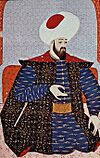 |
c. 1299 – c. 1324 (25 years~) |
N/A |
|
 |
| 2 | Orhan | 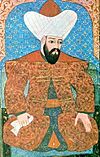 |
c. 1324 – March 1362 (38 years~) |
 |
|
 |
| 3 | Murad I | 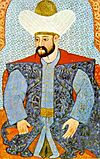 |
March 1362 – 15 June 1389 (27 years, 3 months) |
 |
|
 |
| 4 | Bayezid I | 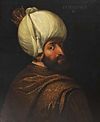 |
15 June 1389 – 20 July 1402 (13 years, 35 days) |
 |
|
 |
| Time Without a Clear Sultan (20 July 1402 – 5 July 1413) |
||||||
| — | İsa Çelebi |  |
January – March/May 1403 (3–5 months) |
N/A |
|
N/A |
| — | Süleyman Çelebi |  |
20 July 1402 – 17 February 1411 (8 years, 212 days) |
 |
|
 |
| — | Musa Çelebi | 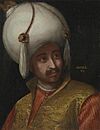 |
18 February 1411 – 5 July 1413 (2 years, 137 days) |
N/A |
|
 |
| — | Mehmed Çelebi | 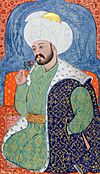 |
1403 – 5 July 1413 (10 years) |
N/A |
|
 |
| Sultanate Resumes | ||||||
| 5 | Mehmed I |  |
5 July 1413 – 26 May 1421 (7 years, 325 days) |
 |
|
N/A |
| — | Mustafa Çelebi | N/A | January 1419 – May 1422 (3 years, 4 months) |
N/A |  |
|
| 6 | Murad II | 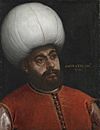 |
25 June 1421 – August 1444 (23 years, 2 months) |
 |
|
  |
| 7 | Mehmed II |  |
August 1444 – September 1446 (2 years, 1 month) |
 |
|
 |
| (6) | Murad II |  |
September 1446 – 3 February 1451 (4 years, 5 months) |
 |
|
N/A |
| Ottoman Empire Grows (1453–1550) |
||||||
| (7) | Mehmed II |  |
3 February 1451 – 3 May 1481 (30 years, 89 days) |
 |
|
 |
| 8 | Bayezid II | 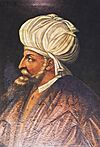 |
19 May 1481 – 25 April 1512 (30 years, 342 days) |
 |
|
 |
| — | Cem Sultan | 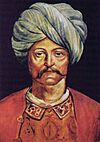 |
28 May – 20 June 1481 (23 days) |
 |
|
 |
| 9 | Selim I |  |
25 April 1512 – 21 September 1520 (8 years, 149 days) |
|
 |
|
| 10 | Suleiman I | 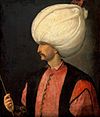 |
30 September 1520 – 6 September 1566 (45 years, 341 days) |
 |
|
 |
| Changes in the Ottoman Empire (1550–1700) |
||||||
| 11 | Selim II | 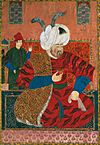 |
29 September 1566 – 15 December 1574 (8 years, 77 days) |
|
  |
|
| 12 | Murad III | 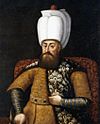 |
27 December 1574 – 16 January 1595 (20 years, 20 days) |
 |
|
 |
| 13 | Mehmed III | 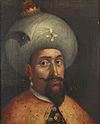 |
16 January 1595 – 22 December 1603 (8 years, 340 days) |
 |
|
 |
| 14 | Ahmed I |  |
22 December 1603 – 22 November 1617 (13 years, 335 days) |
 |
|
 |
| 15 | Mustafa I | 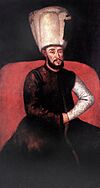 |
22 November 1617 – 26 February 1618 (96 days) |
|
N/A | |
| 16 | Osman II | 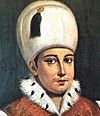 |
26 February 1618 – 19 May 1622 (4 years, 82 days) |
|
 |
|
| (15) | Mustafa I |  |
20 May 1622 – 10 September 1623 (1 year, 113 days) |
|
N/A | |
| 17 | Murad IV | 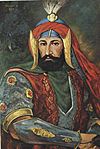 |
10 September 1623 – 8 February 1640 (16 years, 151 days) |
 |
|
N/A |
| 18 | Ibrahim | 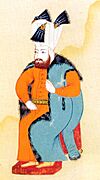 |
9 February 1640 – 8 August 1648 (8 years, 181 days) |
 |
|
N/A |
| 19 | Mehmed IV |  |
8 August 1648 – 8 November 1687 (39 years, 92 days) |
 |
|
N/A |
| 20 | Suleiman II | 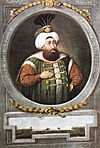 |
8 November 1687 – 22 June 1691 (3 years, 226 days) |
|
 |
|
| 21 | Ahmed II | 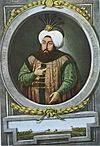 |
22 June 1691 – 6 February 1695 (3 years, 229 days) |
 |
|
N/A |
| 22 | Mustafa II | 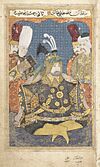 |
6 February 1695 – 22 August 1703 (8 years, 197 days) |
 |
|
 |
| Decline and Reform (1700–1827) |
||||||
| 23 | Ahmed III | 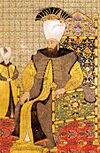 |
22 August 1703 – 1 October 1730 (27 years, 40 days) |
 |
|
 |
| 24 | Mahmud I | 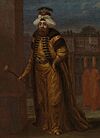 |
2 October 1730 – 13 December 1754 (24 years, 72 days) |
 |
|
 |
| 25 | Osman III | 13 December 1754 – 30 October 1757 (2 years, 321 days) |
|
 |
||
| 26 | Mustafa III | 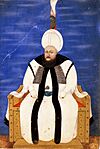 |
30 October 1757 – 21 January 1774 (16 years, 83 days) |
 |
|
  |
| 27 | Abdul Hamid I | 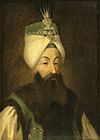 |
21 January 1774 – 7 April 1789 (15 years, 76 days) |
 |
|
 |
| 28 | Selim III | 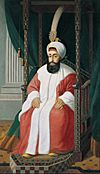 |
7 April 1789 – 29 May 1807 (18 years, 52 days) |
 |
|
 |
| 29 | Mustafa IV | 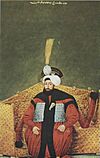 |
29 May 1807 – 28 July 1808 (1 year, 60 days) |
 |
|
N/A |
| Modern Ottoman Empire (1827–1908) |
||||||
| 30 | Mahmud II | 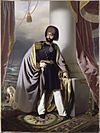 |
28 July 1808 – 1 July 1839 (30 years, 338 days) |
 |
|
  |
| 31 | Abdulmejid I |  |
1 July 1839 – 25 June 1861 (21 years, 359 days) |
 |
|
  |
| 32 | Abdulaziz | 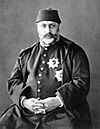 |
25 June 1861 – 30 May 1876 (14 years, 340 days) |
 |
|
  |
| 33 | Murad V |  |
30 May – 31 August 1876 (93 days) |
 |
|
N/A |
| 34 | Abdul Hamid II | 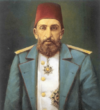 |
31 August 1876 – 27 April 1909 (32 years, 239 days) |
 |
|
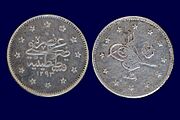 |
| 35 | Mehmed V |  |
27 April 1909 – 3 July 1918 (9 years, 67 days) |
 |
|
 |
| 36 | Mehmed VI | 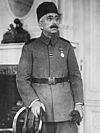 |
4 July 1918 – 1 November 1922 (4 years, 120 days) |
 |
|
 |
| Caliph under the Grand National Assembly of Turkey (1 November 1922 – 3 March 1924) |
||||||
| — | Abdulmejid II |  |
19 November 1922 – 3 March 1924 (1 year, 106 days) |
— |
|
— |
Images for kids
See also
- Line of succession to the Ottoman throne
- Ottoman Sultan family tree
- List of valide sultans
- List of Ottoman grand viziers


